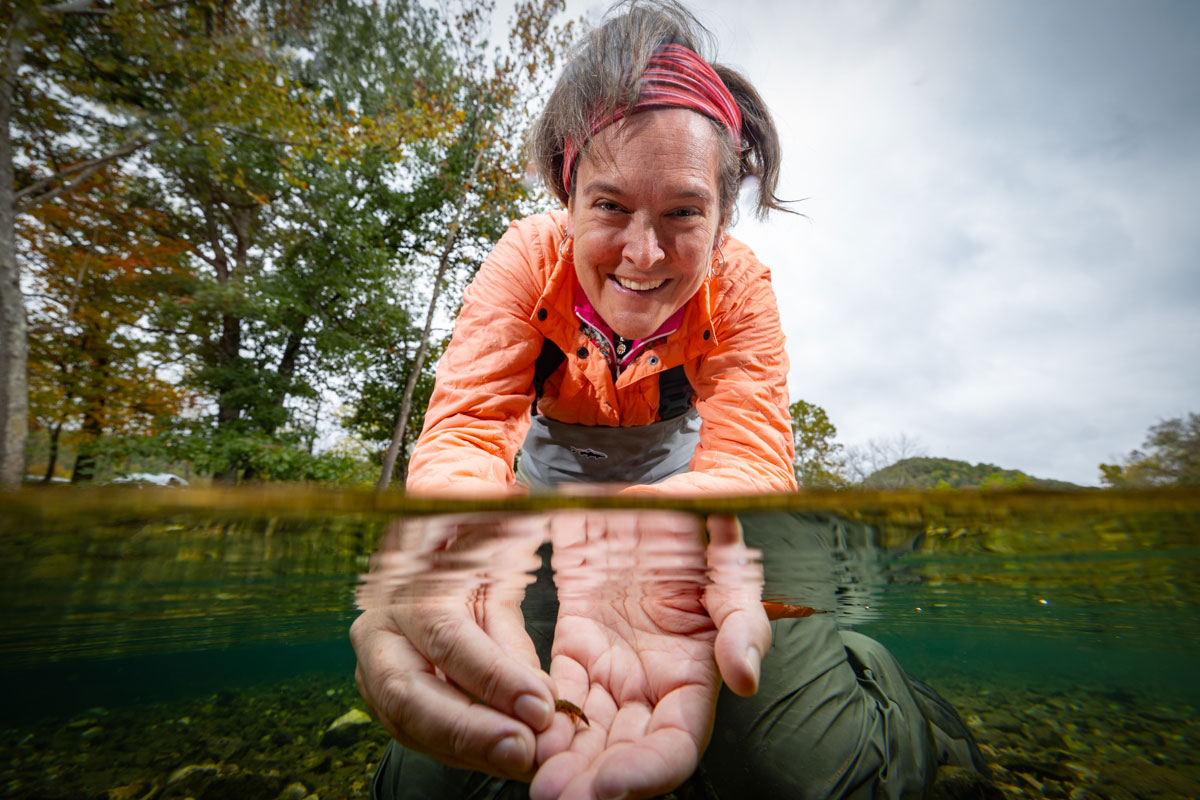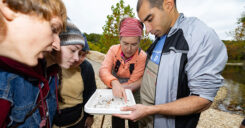
Deciphering the disturbances
Standing in the middle of a running stream, golden sunlight dapples the surface of the water. Gravel underfoot provides a slightly uneven texture. The sound of running water fills the air.
But a disturbance such as a flash flood can turn a shiny stream into a muddy mess of churning gravel in an instant, displacing what lives beneath the waters.
Yet, the streams still flourish.
A love for biology and landscape spatial patterns fuels Dr. Debra Finn’s passion for understanding stream ecology. She has more than 45 publications about streams to her name.
An associate professor of biology at Missouri State University, Finn is driven to understand complexities that lie beneath the water, and how connectivity enables streams to flourish despite disturbances.
Dynamic adaptations
In ecology, a disturbance is any event that can displace or kill organisms living in an area. In streams, one major disturbance is flash floods.
Ozark streams experience flash floods frequently. These have become an obsession for Finn.
“Streams in particular are very dynamic and have a lot of biodiversity,” she said. “But when you go out right after a flood, the stream looks like it’s been decimated. How is it possible that the organisms beneath the water can recover so quickly?”
Natural disturbances are important. If organisms and streams have adaptations to be resilient to the natural disturbances, they might be well positioned to adapt to continued extremes.
“Climate change is causing extremes, like bigger floods and more severe droughts,” Finn said. “Are streams going to be able to withstand that? Can we find ways that they respond to this and can continue to adapt even to all these pressures we’re putting on them?”

Discovering what’s below
In 2017, Nathan Dorff was a student researcher working with Finn. One day in the lab, he curiously peered through a microscope. “Well, I’ve sure never seen anything like this before,” he said.
He pulled out his phone to photograph what he saw through the microscope lens. He sent the photos to several people, hoping someone would recognize the unfamiliar creature. No one did, because — as it turned out — Dorff had just spotted a new species.
Through his microscope, he was looking at a previously unidentified frog-biting midge from an obscure group of flies in the order Diptera.
“It looked like a combination of a mosquito larva and a predaceous fly larva,” he said. “It wasn’t until nearly a year later I began to realize I had indeed discovered something unique.”
Below the streambed, where surface water and ground water mix, is the hyporheic zone. This is where Dorff made his discovery while doing thesis research with Finn on the hyporheic zone’s resilience to flood disturbance.
To collect hyporheic animals as a part of his research for his master of science in biology, he drove wells into the streambed of Bull Creek.
“We dedicated the discovery to the landowners of Bull Mills by naming the new species after them: Corethrella kipferi.”
Dorff’s discovery was published in 2022 in the Journal of Natural History.
Finding a new species alone is momentous. But Dorff’s is especially important as it further highlights the importance of understanding biodiversity nuances, like what’s living beneath the surface of streams, even when there’s no water. 
Within the gravels
A dried-up stream leaves a path of gravel to walk on. But to Finn and her students, it’s still a stream. Small invertebrates live within the gravel, waiting for the next rain.
“You can collect a sample of gravel, put it in a bucket with water, and wait a few weeks, you have invertebrates coming out of a state of diapause,” Finn said.
Diapause is a resting stage where creatures stop their metabolism for a while and wait for a cue to continue growing. Here, the cue is water returning to the stream. During a flood, water fills the gaps in the gravel, signaling the invertebrates to continue their life cycle.
“This shows that these dry places that people wouldn’t even recognize as a stream are chock full of aquatic organisms just waiting it out,” Finn said. “To me, that’s clearly a stream.”
The organisms in the gravel grow fast and produce a load of food by “converting those rotting leaves and algae into delicious, yummy protein as fuel for fish and birds,” Finn said. Streams are streams, water or not.
More than a line on a map
Streams are more than skinny bodies of water depicted as a thin blue line on a map. But many don’t realize the importance of the connections streams make to everything around them.
“Streams rely on connectivity between their surface and what’s going on underneath the surface that we can’t see,” Finn said. “They also interact with the land around them, exchanging resources in both directions. Without food resources from the land, you couldn’t have all those fish. And without insects produced from the stream, you would have fewer birds and bats.”
A lack of general understanding leads to human activities that can sever these important connections. Construction projects or dumping sediment into dry streams change everything in terms of the stream’s existence.
There’s space in between the gravel for organisms to crawl around in. But if a big deposit of mucky sediment fills the gaps, it’s suddenly a wall in the water, breaking the connection with the rest of the stream.
“We might be destroying species that will never be discovered.”


An amazing bit of information. I’m so thankful to learn something new about my world around me.
Very impressed by Dr. Finn and her students. Great work!